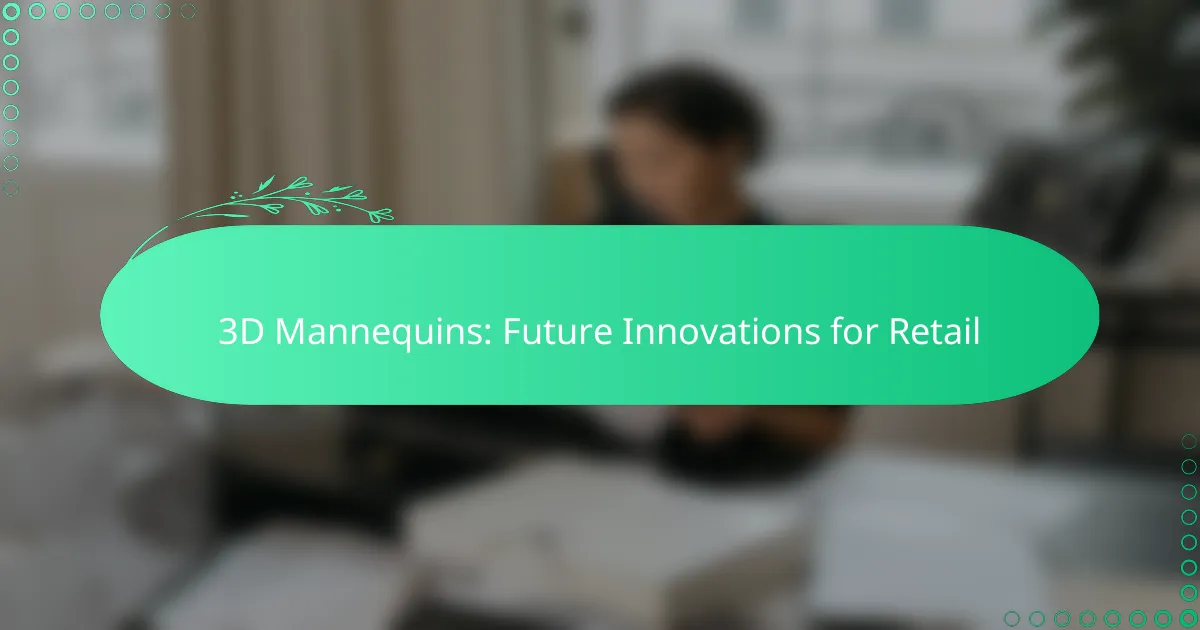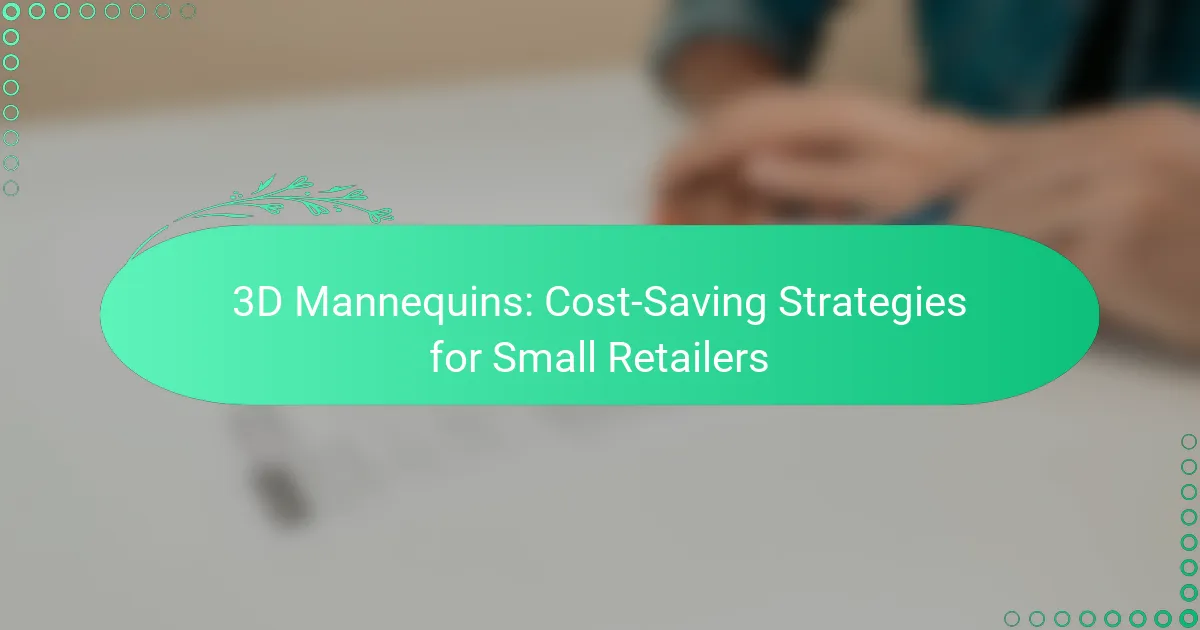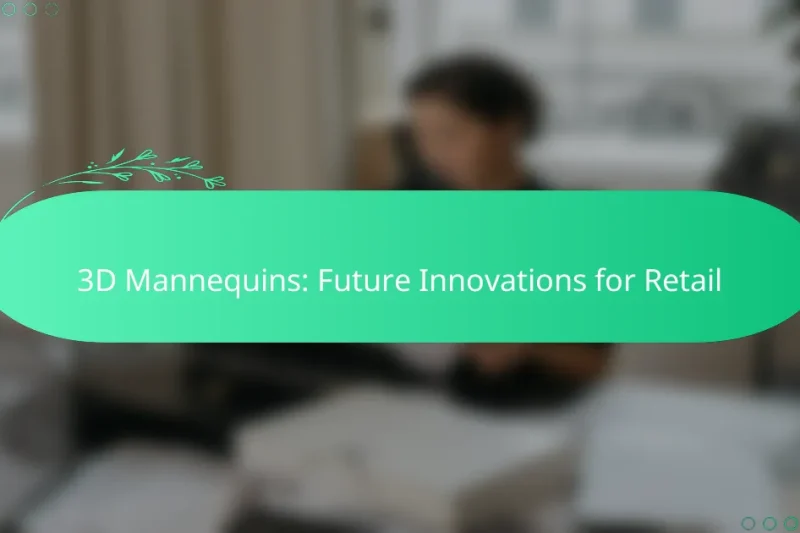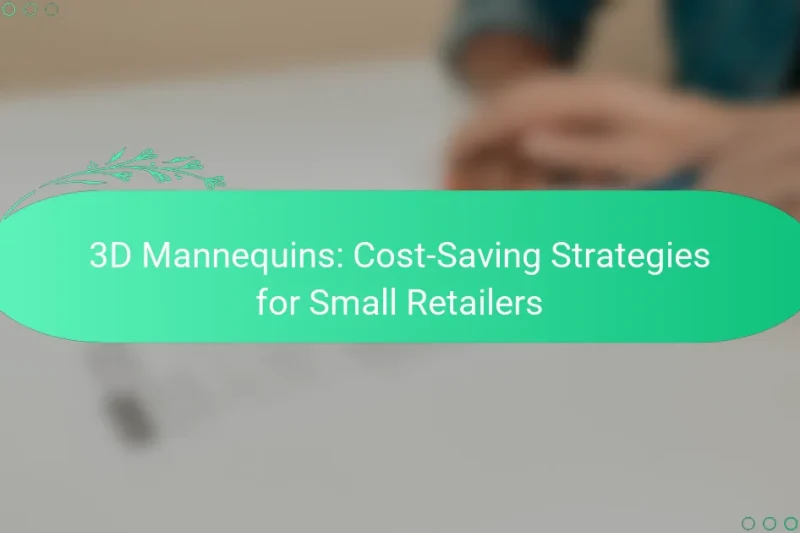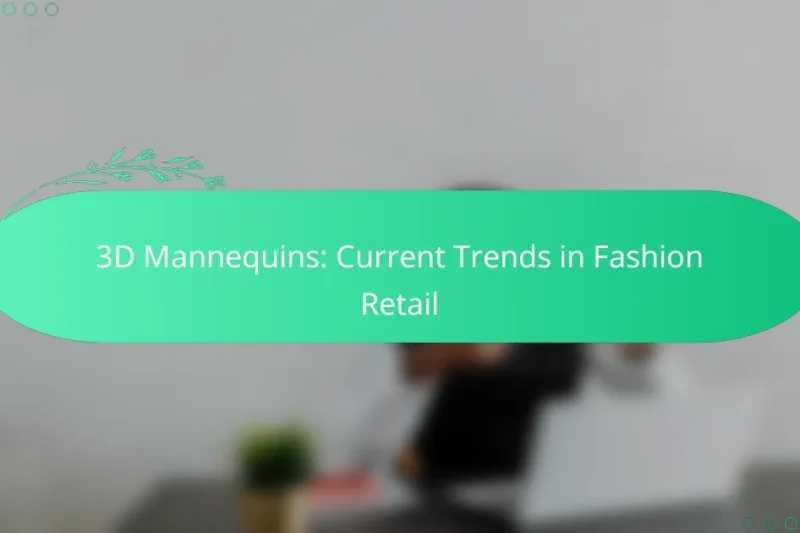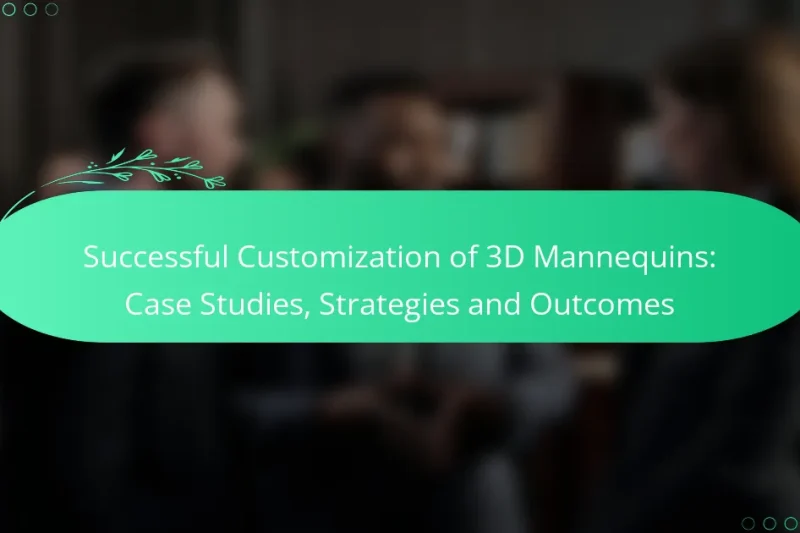3D mannequins play a crucial role in enhancing seasonal promotions by delivering visually captivating displays that … 3D Mannequins: Seasonal Promotions, Adaptability and Marketing StrategiesRead more
3D mannequins are revolutionizing the retail and e-commerce landscape by offering customers a realistic and interactive way to visualize products. By allowing shoppers to see how items fit and look in a three-dimensional space, these solutions create a more engaging and immersive shopping experience, ultimately driving sales and reducing return rates.
3D Mannequins: Future Innovations for Retail
3D mannequins are transforming the retail landscape by providing dynamic visual merchandising and immersive shopping experiences. … 3D Mannequins: Future Innovations for RetailRead more
3D Mannequins: Total Cost of Ownership, Budgeting Insights and Price Comparisons
When considering 3D mannequins, it’s essential to evaluate the total cost of ownership (TCO), which includes … 3D Mannequins: Total Cost of Ownership, Budgeting Insights and Price ComparisonsRead more
3D Mannequins: E-Commerce Integration and User Experience
3D mannequins are revolutionizing the e-commerce landscape by offering realistic product representations that enhance user experience. … 3D Mannequins: E-Commerce Integration and User ExperienceRead more
3D Mannequins: Cost-Saving Strategies for Small Retailers
Small retailers can significantly cut costs by utilizing 3D mannequins, which help reduce shipping expenses and … 3D Mannequins: Cost-Saving Strategies for Small RetailersRead more
3D Mannequins: User Preferences and Design Appeal
In the evolving landscape of retail, 3D mannequins play a crucial role in enhancing customer engagement … 3D Mannequins: User Preferences and Design AppealRead more
3D Mannequins: Financing Options and Purchase Strategies
Acquiring 3D mannequins can be streamlined through various financing options such as leasing, installment plans, and … 3D Mannequins: Financing Options and Purchase StrategiesRead more
3D Mannequins: Current Trends in Fashion Retail
3D mannequins are transforming the fashion retail landscape by offering interactive and dynamic displays that significantly … 3D Mannequins: Current Trends in Fashion RetailRead more
3D Mannequins: User Feedback, Retail Environment Insights and Experience
3D mannequins are revolutionizing retail environments by offering an engaging and interactive way to display products, … 3D Mannequins: User Feedback, Retail Environment Insights and ExperienceRead more
Successful Customization of 3D Mannequins: Case Studies, Strategies and Outcomes
In the competitive landscape of retail, successful customization of 3D mannequins plays a crucial role in … Successful Customization of 3D Mannequins: Case Studies, Strategies and OutcomesRead more
How do 3D mannequins enhance retail and e-commerce?
3D mannequins significantly enhance retail and e-commerce by providing a realistic and interactive way for customers to visualize products. They allow shoppers to see how items fit and look in a three-dimensional space, leading to a more engaging shopping experience.
Improved customer engagement
3D mannequins capture customer attention more effectively than traditional images or videos. By allowing customers to interact with products in a virtual environment, retailers can create a more immersive experience that encourages exploration and longer browsing times.
For instance, virtual fitting rooms using 3D mannequins enable customers to try on clothes digitally, which can lead to increased interest and interaction with the brand. This engagement can be further enhanced through social sharing features, where customers can showcase their virtual outfits.
Increased conversion rates
Utilizing 3D mannequins can lead to higher conversion rates as they provide customers with a clearer understanding of product fit and style. Studies suggest that interactive product displays can boost sales by a notable percentage, as customers feel more confident in their purchasing decisions.
Retailers should consider integrating 3D mannequins into their websites and physical stores to facilitate this. Offering features like zooming in on details or rotating the mannequin can help customers make quicker decisions, reducing cart abandonment rates.
Enhanced product visualization
3D mannequins allow for enhanced product visualization, showcasing items from various angles and in different contexts. This capability helps customers better understand the size, shape, and overall appeal of products, which is particularly important for clothing and accessories.
Retailers can use 3D models to simulate different settings, such as casual or formal environments, to help customers envision how products fit into their lives. Providing a realistic representation of products can significantly influence purchasing behavior and satisfaction.
What are the best 3D mannequin solutions for retailers?
The best 3D mannequin solutions for retailers enhance online shopping experiences by providing realistic representations of products. These technologies help customers visualize clothing fit and style, ultimately driving sales and reducing return rates.
Stylitics 3D mannequins
Stylitics offers a platform that creates dynamic 3D mannequins tailored to specific brands and styles. Their technology allows retailers to showcase a wide range of outfits on customizable virtual models, enhancing customer engagement.
Retailers should consider Stylitics for its ability to integrate seamlessly with existing e-commerce platforms. Additionally, the solution provides analytics to track customer interaction with the 3D models, helping retailers refine their offerings.
3DLOOK virtual fitting solutions
3DLOOK specializes in virtual fitting solutions that use body scanning technology to create accurate 3D representations of customers. This allows shoppers to see how clothing fits their unique body shape, reducing uncertainty during online purchases.
Retailers can benefit from 3DLOOK by offering personalized shopping experiences that cater to individual body types. This can lead to higher conversion rates and lower return rates, making it a valuable investment for e-commerce businesses.
Vue.ai mannequin technology
Vue.ai provides AI-driven mannequin technology that generates 3D models from 2D images. This solution is particularly useful for retailers looking to quickly scale their online presence without extensive photography sessions.
By utilizing Vue.ai, retailers can automate the creation of 3D mannequins, saving time and resources. It's essential to ensure that the quality of the 2D images meets the platform's requirements for optimal results.
How to choose the right 3D mannequin for your business?
Choosing the right 3D mannequin for your business involves understanding your specific needs, ensuring compatibility with your existing software, and considering your budget. This decision can significantly impact how effectively you showcase products online or in-store.
Assessing business needs
Start by identifying the purpose of the 3D mannequin in your retail or e-commerce strategy. Consider whether you need it for product visualization, virtual fitting rooms, or marketing campaigns. Each use case may require different features and levels of detail.
For example, if your focus is on high-end fashion, you might need a mannequin that accurately represents fabric draping and movement. Conversely, for basic apparel, a simpler model may suffice.
Evaluating software compatibility
Ensure that the 3D mannequin you choose is compatible with your current software systems, such as e-commerce platforms or design tools. Check if it supports common file formats like OBJ or FBX, which are widely used in 3D modeling.
Additionally, consider whether the mannequin integrates seamlessly with your website or virtual showroom. This can save time and reduce technical issues during implementation.
Considering budget constraints
Your budget will play a crucial role in selecting a 3D mannequin. Prices can vary widely based on features, quality, and customization options. Basic models may start in the low hundreds of USD, while more advanced, customizable options can reach into the thousands.
It’s essential to weigh the cost against the potential return on investment. Investing in a high-quality mannequin that enhances customer engagement could lead to increased sales and brand loyalty.
What are the pricing ranges for 3D mannequins?
The pricing for 3D mannequins varies widely based on the type of model and the purchasing method. Generally, you can expect costs to range from a few hundred to several thousand dollars, depending on features and customization options.
Subscription models
Subscription models for 3D mannequins typically charge a monthly fee, allowing retailers to access a library of digital mannequins. Prices can range from around $50 to $500 per month, depending on the number of models and features included.
These models often come with updates and new designs, making them a flexible option for businesses that frequently change their displays. However, long-term costs can add up, so it’s essential to evaluate how often you will use the service.
One-time purchase costs
One-time purchase costs for 3D mannequins can vary significantly, often starting from about $300 for basic models and reaching up to $5,000 or more for highly detailed, customizable options. The price usually reflects the quality, realism, and versatility of the mannequin.
When considering a one-time purchase, assess your long-term needs. If you plan to use the mannequin for multiple seasons or campaigns, investing in a higher-quality model may be more cost-effective in the long run.
Custom development pricing
Custom development pricing for 3D mannequins can be quite variable, often ranging from $1,000 to $10,000 or more based on complexity and specific requirements. This option is ideal for brands seeking unique designs that align closely with their identity.
When opting for custom development, ensure you clearly communicate your vision and requirements to avoid unexpected costs. Additionally, consider the timeline for development, as custom projects may take longer than off-the-shelf solutions.
What are the benefits of using 3D mannequins in major cities?
3D mannequins offer significant advantages for retail and e-commerce in major cities by enhancing customer engagement and providing tailored marketing solutions. These digital models allow businesses to showcase products in a visually appealing way, attracting urban shoppers who value innovation and personalization.
Localized marketing strategies
Localized marketing strategies using 3D mannequins can effectively target specific demographics in urban areas. Retailers can customize the appearance and clothing of mannequins to reflect local fashion trends, cultural events, or seasonal preferences, making the shopping experience more relatable for city dwellers.
For example, a clothing store in Paris might feature 3D mannequins dressed in styles that resonate with Parisian fashion, while a store in New York could highlight streetwear trends. This tailored approach can increase foot traffic and online engagement.
Competitive advantage in urban markets
In competitive urban markets, 3D mannequins provide a distinct edge by differentiating brands from their competitors. The ability to create dynamic and interactive displays can capture the attention of passersby, leading to higher conversion rates both in-store and online.
Moreover, the use of 3D mannequins can streamline inventory management by allowing retailers to showcase a wider range of products without the need for physical stock. This flexibility can help businesses adapt quickly to changing consumer preferences and market trends.
What are the emerging trends in 3D mannequin technology?
Emerging trends in 3D mannequin technology include enhanced realism, customization options, and integration with digital platforms. Retailers are increasingly adopting these advanced mannequins to improve customer engagement and streamline the shopping experience.
Integration with augmented reality
Integration with augmented reality (AR) allows customers to visualize products in a more immersive way. Retailers can use AR to superimpose 3D mannequins into real-world environments, enabling shoppers to see how clothing fits and looks without physically trying it on.
This technology works by using a smartphone or tablet camera to capture the user's surroundings, then layering the digital mannequin over the live view. Retailers should ensure that the AR experience is user-friendly and accessible to maximize customer interaction.
To implement AR effectively, retailers should consider the following: invest in high-quality 3D models, ensure compatibility with popular AR platforms, and provide clear instructions for users. Avoid overly complex interfaces that may deter potential customers from engaging with the technology.

